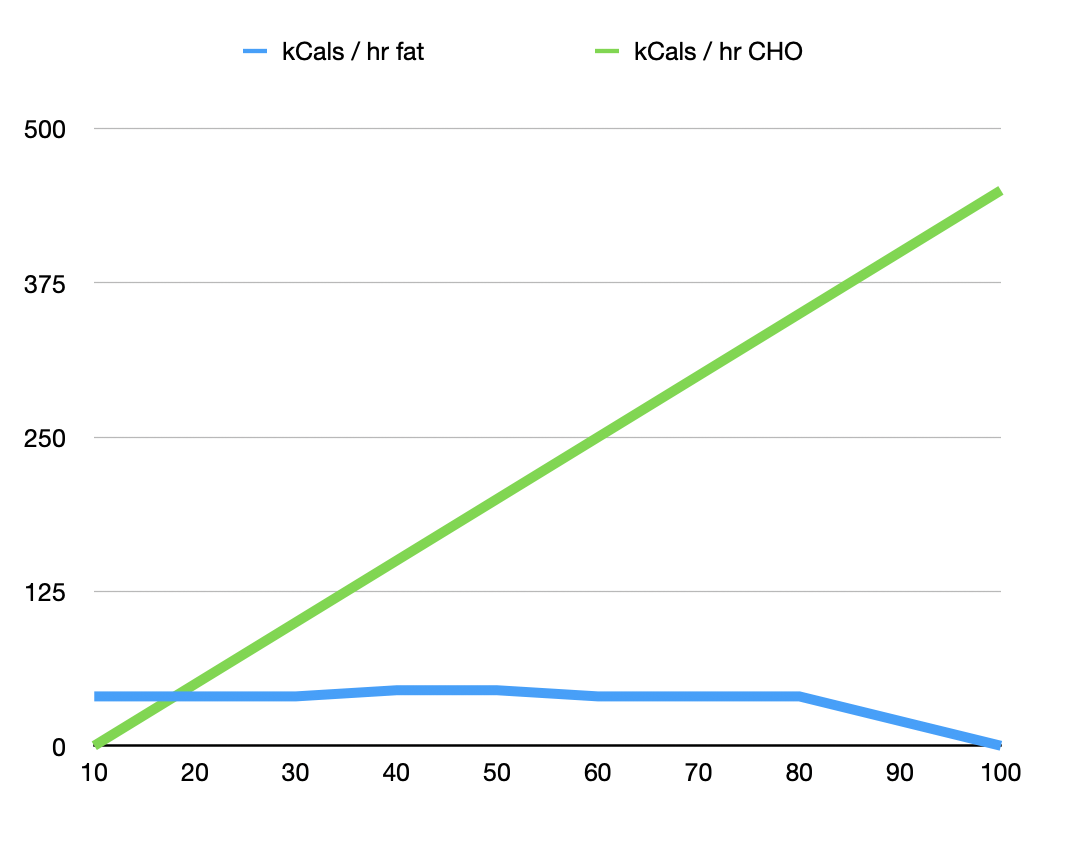The “fat burning zone” is a myth
The conecpt of a "fat-burning zone" (an intensity where you burn the most fat) is still widely promoted by fitness influencers (and even sports equipment manufacturers), but it’s largely based on a misunderstanding of a widely-shared graph showing fat and carbohydrate (CHO) use as a percentage of total energy at different exercise intensities. It looks something like this:
My axis labels disappeared, it's exercise intensity on the x-axis (as %) and energy utilisation (%) on the y-axis. Note this is a simplified example, figures are not meant to be exact.
This simplified graph shows the proportion of fat and carbohydrates your body uses for fuel at various intensities (there is some individual variation). However, many people have overlooked a critical factor: the total amount of energy burned. When we consider the actual number of calories expended, the graph looks more like this:
Note, both graphs are simplified and kCals are to give you the gist (not exact and varies by person). y-axis: total number of calories expended, x-axis energy intensity (%).
Even though the percentage of fat used may decrease as exercise intensity increases, the total number of calories burned rises dramatically. Thus, the amount of fat burned doesn’t drop off sharply and there is no “cross over zone” where you “switch” from burning fat to CHO. At higher intensities, your body still burns fat, but it also starts using more carbohydrates to meet increased energy demands. The result? You burn more total calories.
The “fat burning zone”
The so-called “fat-burning zone” suggests there’s an optimal intensity range for burning fat, but this mischaracterises how energy metabolism works. While it’s true that lower-intensity exercise relies more heavily on fat as a fuel source, the total amount of fat burned remains relatively consistent across most exercise intensities, except at very high levels, which you won’t be able to sustain very long anyway.
At higher intensities, your body also uses more blood glucose and glycogen for energy. The increased calorie expenditure means you’re burning more overall. What this means is that you don’t need to stay in some mythical “zone” to burn fat. For most ultra runners this isn’t so much about losing fat as wanting to get better at utilising fat as fuel. This will be achieved by a balanced training programme with exercise at all intensities.
Low-intensity exercise:
Low-intensity activities like walking, cycling, or slow (for you) running are important. They improve aerobic fitness, build endurance, and support metabolic health. Additionally, low-intensity exercise is more sustainable for longer durations. This is crucial for overall health and fat loss over time (if that’s your goal). For many people it’s also an opportunity to destress, decompress and think.
High-intensity exercise:
On the other hand, higher-intensity workouts burn more total calories in a shorter period and offer benefits like increased post-exercise oxygen consumption (EPOC), where your body continues to burn calories after you’ve finished. Higher intensity efforts also increase your cardiovascular fitness, improve anaerobic capacity, stimulate growth hormones and hone your mental toughness - all of which equal faster races!
Key point:
The idea of a fat-burning zone is a myth. Most ultra runners who bring up this idea are responding to a mix of confusing messages around the “fat burning zone” where they believe it is both real and trainable. It is not real, but the separate issue of whether we can get better at utilising fat as fuel has the same answer I’ve given here: a balanced training program will improve your fat oxidisation and endurance, strength and overall fitness.

